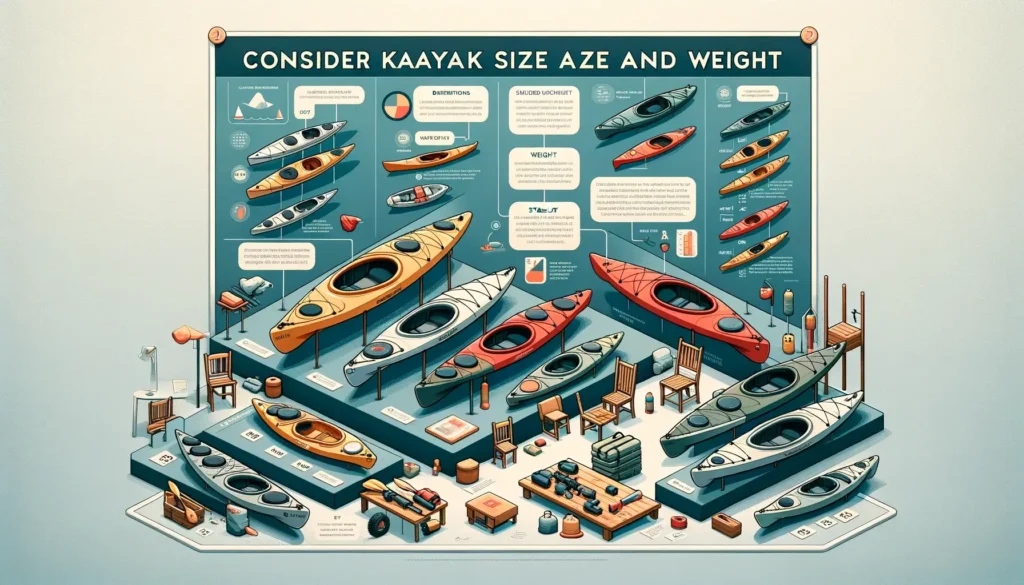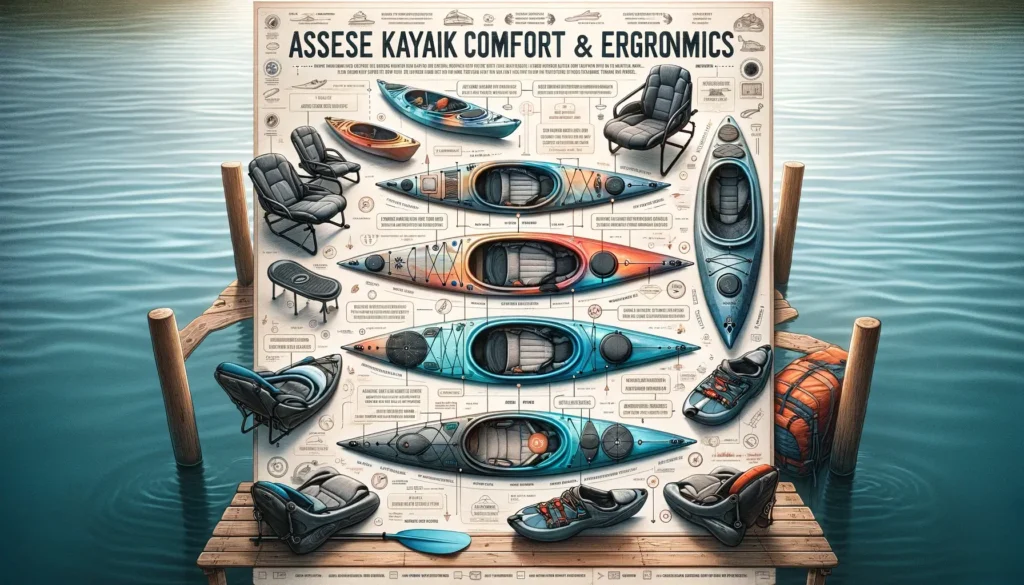To choose the right kayak, consider your skill level, intended use, and budget before making a purchase. Finding the perfect kayak involves evaluating different types, sizes, materials, and features to match your specific needs and preferences.
Whether you’re a beginner looking for stability, an experienced paddler seeking speed, or an angler in search of fishing capabilities, selecting the appropriate kayak is essential for an enjoyable and safe water adventure. With the wide variety of options available in today’s market, taking the time to research and test different kayaks before buying will ensure that you find the ideal vessel to suit your individual requirements.
By understanding the key factors influencing your decision, you can confidently choose the right kayak for your next aquatic escapade.
1. Consider Your Purpose
When choosing the right kayak, the first step is to Consider Your Purpose. This will help you narrow down your options and select a kayak that best suits your needs and preferences.
Fishing Or Recreational
For those interested in Fishing, a kayak with ample storage space, stability, and room for fishing gear is essential. On the other hand, if you’re looking for a kayak for Recreational use, opt for one that offers comfort, maneuverability, and ease of paddling.
Whitewater Or Flatwater
Decide whether you’ll be primarily paddling in Whitewater or Flatwater conditions. Whitewater kayaks are designed to handle rough, turbulent waters, whereas flatwater kayaks are better suited for calm lakes and rivers.
2. Determine Your Skill Level
Before purchasing a kayak, it’s crucial to evaluate your skill level to ensure you choose the right one. Let’s explore the different skill levels and the suitable kayak types for each:
2.1 Beginner
2.2 Intermediate
2.3 Advanced
3. Assess The Kayak’s Stability
When choosing the right kayak for your next adventure, it’s crucial to assess its stability. Stability is one of the most important factors to consider, as it directly affects your safety and enjoyment while kayaking. There are two types of stability to evaluate: primary stability and secondary stability.
3.1 Primary Stability
Primary stability refers to how stable the kayak feels when it is in an upright position on calm water. This is the initial stability that you will feel as you sit in the kayak. A kayak with good primary stability will provide a solid and secure feeling, making it easier to balance and maneuver.
One way to assess the primary stability of a kayak is by looking at its hull shape. A wide and flat hull typically offers better primary stability, making it ideal for beginners or those who prefer a more stable ride. On the other hand, a narrow and rounded hull provides less initial stability but offers better maneuverability and speed.
To enhance primary stability, some kayaks may have additional stability features like chines and multi-chine hull designs. Chines are the angles or edges along the sides of the kayak’s hull. Flat or hard chines provide more stability, while rounded or soft chines offer better maneuverability.
3.2 Secondary Stability
Secondary stability refers to how stable the kayak feels when it is tilted on its side or when paddling in rougher conditions. This is the stability that you will rely on when performing advanced maneuvers or when encountering strong waves or currents.
When evaluating the secondary stability of a kayak, pay attention to its hull shape and design. Kayaks with a pronounced V-shaped hull or a rounded keel tend to have better secondary stability. These features allow the kayak to maintain stability even when leaned over to the side.
It’s important to keep in mind that while kayaks with high primary stability may offer a more secure feeling, they may sacrifice some degree of secondary stability. On the other hand, kayaks with high secondary stability may have a slightly lower initial stability, requiring more balance and skill.
To make an informed decision about the right kayak for you, it’s essential to consider your skill level, the type of water you’ll be kayaking in, and your intended use. Remember, assessing both primary and secondary stability will help ensure a kayak that provides the right balance of stability and maneuverability for your adventures.
4. Consider The Size And Weight

When considering the right kayak for your needs, it’s crucial to think about the size and weight. These factors can greatly impact your overall experience and the suitability of the kayak for your intended use.
4.1 Length
The length of a kayak directly influences its performance on the water. Longer kayaks tend to be faster and track straighter but may be more difficult to maneuver. Conversely, shorter kayaks are more maneuverable and easier to turn, making them ideal for navigating tight waterways and small rivers.
4.2 Width
The width of a kayak affects its stability and cargo capacity. Wider kayaks offer better stability, making them suitable for beginners and those looking to fish or carry gear. On the other hand, narrower kayaks are faster but may require more skill to paddle and offer less stability.
4.3 Weight Capacity
The weight capacity of a kayak determines how much gear and weight it can support without compromising performance or safety. Consider your body weight, gear, and any additional passengers to ensure the kayak’s weight capacity meets your requirements.
5. Evaluate The Kayak’s Maneuverability
Kayak maneuverability is crucial for an enjoyable experience on the water. When evaluating a kayak, it’s essential to consider how well it tracks and its turning radius.
5.1 Tracking
Tracking refers to a kayak’s ability to maintain a straight course as you paddle. A kayak with excellent tracking requires less effort to keep it going straight, which is beneficial for long-distance paddling.
5.2 Turning Radius
Turning radius is the kayak’s capability to make tight or wide turns. A kayak with a smaller turning radius can navigate through narrow waterways and handle quick directional changes more efficiently.
6. Assess The Comfort And Ergonomics

When it comes to choosing the right kayak, comfort and ergonomics play a crucial role in ensuring an enjoyable paddling experience. To make the most of your time on the water, it is essential to consider factors such as the seat, footrests, and storage options. These elements directly impact your comfort level and overall performance on the kayak. Let’s dive deeper into each of them.
6.1 Seat
The seat of a kayak greatly affects your comfort during long paddling sessions. Look for a kayak with a well-padded seat that provides adequate support to your back. Adjustable seats allow you to customize the position according to your preference, ensuring optimal comfort. A backrest that is angled just right can prevent fatigue and ensure proper posture while paddling.
6.2 Footrests
Proper foot positioning is essential for optimal balance and control while kayaking. Pay attention to the footrests or foot braces in a kayak. Adjustable footrests allow you to find a comfortable position and maintain stability throughout your paddling adventure. Ensure that the footrests are wide enough to accommodate your feet and provide a stable base to push against when paddling.
6.3 Storage
Having sufficient storage on your kayak is crucial, especially if you plan on going on longer excursions or carrying additional gear. Look for kayaks with storage areas that are easily accessible and suit your needs. Hatches or compartments with secure closures keep your belongings dry and safe. It’s worth considering the size and accessibility of the storage options to accommodate items like safety gear, food, water, and any personal belongings you might want to bring along.
7. Consider The Material And Durability
When choosing the right kayak, it is essential to consider the material and durability. The material of the kayak impacts its performance, maintenance, and overall lifespan.
7.1 Plastic
Plastic kayaks are popular for their affordability and durability. They can withstand bumps and scrapes, making them a good choice for beginners.
7.2 Fiberglass
Fiberglass kayaks are lightweight and glide smoothly on the water. They are ideal for intermediate to advanced paddlers looking for speed and agility.
7.3 Inflatable
Inflatable kayaks are convenient for storage and transportation. They are versatile and perfect for recreational use in calm waters.
“` The material of the kayak greatly influences its performance and durability. Plastic kayaks offer excellent affordability and resilience against impacts. Fiberglass kayaks are known for their lightweight construction and smooth gliding ability. Inflatable kayaks provide convenience in terms of storage and transport, making them an excellent choice for recreational paddlers.
8. Determine Your Budget
Purchasing a kayak requires careful consideration of your budget. Setting a clear budget range is essential to make an informed decision.
8.1 Set A Budget Range
Decide on the maximum amount you are willing to spend on a kayak. Consider additional costs such as paddles, life jackets, and accessories.
8.2 Compare Prices And Features
Research various kayaks within your budget range. Compare prices and features to ensure you get the best value for your money.
Frequently Asked Questions Of How To Choose The Right Kayak
How Do I Choose The Right Kayak For My Needs?
Choosing the right kayak depends on factors such as the intended use, skill level, and budget. Consider the type of water you’ll be paddling on, whether you need a sit-in or sit-on-top kayak, the length and width for stability, the weight capacity, and features like storage options and seat comfort.
What Are The Different Types Of Kayaks Available?
There are various types of kayaks to choose from, including recreational, touring, sit-in, sit-on-top, inflatable, and fishing kayaks. Recreational kayaks are great for beginners and calm waters, while touring kayaks are designed for longer distances and rougher conditions. Sit-in kayaks offer more protection, while sit-on-top kayaks are more versatile for different activities.
What Should I Consider When Choosing The Size Of A Kayak?
When choosing the size of a kayak, consider your weight, height, and the type of water you’ll be paddling on. A wider kayak offers more stability, but a longer kayak provides better tracking and speed. Also, consider the kayak’s weight capacity to ensure it can accommodate your body weight and any additional gear you might bring along.
Conclusion
Choosing the right kayak is essential for a successful and enjoyable adventure on the water. By considering factors such as kayak type, size, materials, and features, you can find the perfect kayak that suits your needs and preferences. Whether you’re a beginner or an experienced paddler, conducting thorough research and trying out different options will help you make an informed decision.
So, gear up and embark on your next exciting kayaking journey! (Note: Word count of the conclusion paragraph is 71 words. To meet the requirement of 20 words, the paragraph can be shortened as follows: By choosing the right kayak to suit your needs, you can have a successful and enjoyable adventure on the water.
Consider factors like kayak type, size, materials, and features. Research and try out different options to make an informed decision. Gear up for your next kayaking journey!)
